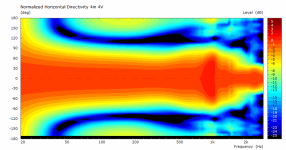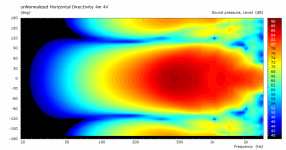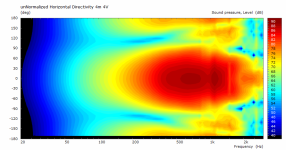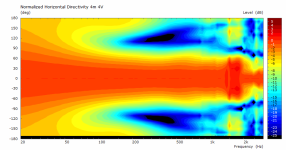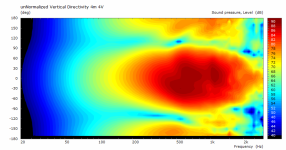So I go to my desk, play a song, apply low pass
Sorry the sub is on my left, I can hear it louder in my left ear.... if I turn my chair and face my right ear.... I can tell its louder in right ear...Who can't do this?
This sub is 1m and corner loaded. I wanted to talk about how I can hear the corner now as opposed to the how the bass was percieved being near the middle of the room, upstairs, but I should save it for my thread.
How are you sure your room is not playing a trick on you? Maybe the fact you are in such close proximity have an importance too? After all if you used a cardioid mic you know proximity effect can change a lot the timbre of source ( don't make me said your sub behave as an unidirectional capsule, that is not my point!)... Many things could be at play.
And those are sighted test. It can really change a lot of things too. Don't jump at definitive answers if you want to have a scientific approach, especially if it look obvious.
Last edited:
However tempting to write an answer, this has extensively been described at various places. D’Appolito’s book ‘Testing loudspeakers’ for one, or this thread. Various places on this forum give insights too.Could you explain more about the "gated measurement" please? Do you perform it in an untreated room?
But yes, the room is untreated. The measurement essentially blocks reflections out by time-windowing the measured signal. Reflections arrive later than the source sound. And thus can be separated from the source sound.
You make it sound like that directionality is something that goes in a discrete step, from totally audible, to entirely inaudible?I already told and repeat, the global ability of human B_force refers too are an average, some are outside of this average (like for everything). Outside ( with no room mode) i've been able to hear directionality below 80hz... never happened in a room though.
But i felt stereo sub to be different in rendering than 2xmono or multiple mono subs in room.
Obviously this is not a discrete step but goes gradually.
Also it's totally not interesting if something is barely or just about audible.
It's about how it holds against the entire picture in the room and all other acoustics involved.
Science always talks about averages within certainties.
The fact that there is a small percentage of people that has some magical hearing is not really interesting is it?
Another fact is that within that percentage there is a group of people that think they hear things, until they start doing double blind AB or ABX tests.
That percentage gets even smaller in a real practical setting.
Plus going back to what I said before, is that there is always margin of error.
It's a grey scale, not discrete black and white.
The directionality of human hearing is well documented in a plethora of books and literature in acoustics for almost halve a century by now.
I assume that if people want to dive deeper into this field, they are at least familiair with this and understand the nuances.
Ever heard of harmonics or any other additional sounds?So I go to my desk, play a song, apply low pas
s
View attachment 1263753
Sorry the sub is on my left, I can hear it louder in my left ear.... if I turn my chair and face my right ear.... I can tell its louder in right ear...Who can't do this?
This sub is 1m and corner loaded. I wanted to talk about how I can hear the corner now as opposed to the how the bass was percieved being near the middle of the room, upstairs, but I should save it for my thread.
Which become super audible when there is barely any masking effect going on anymore.
Or in other words, have you done the same test with stereo speakers playing at the same time?
Because in the post you responded to, I was talking the practical aspects of things.
NOT about certain things can be heard in isolation!
I am not going into the discussion to question if directionality below a certain frequency is true or not.
Especially not based on some anecdotal little tests without any control over what is exactly happening.
In my opinion you're asking the wrong question then with already adding a judgement to it.
(I noticed, therefor it must be generally true).
The question is, not to question fundamental books and literature of acoustics, but why you actually do hear directionality in this very specific case.
An additional point to this, is that we also have to question how the mix in the music is being done?
Because there are quite some that just go to full mono below 80-150Hz anyway,
So in that case there isn't even a stereo effect going on.
By now you would have read about gating...If the driver becomes nearly omnidirectional at that frequency range we will need a chamber.
Any sound in a room, even a highly directed sound, will come back eventually.. the speaker directivity is not the deciding factor. What matters is the space around you in the room, and how much time you have.
Yes, a friend in this forum showed it to me, but I'm still not completely sure about itBy now you would have read about gating...
Any sound in a room, even a highly directed sound, will come back eventually.. the speaker directivity is not the deciding factor. What matters is the space around you in the room, and how much time you have
Hi, B_Force,
It was in no way my intention to give the impression this is not gradual, we agree: it is gradual. I would add too that in my experience it is room related ( if room is involved): the ability to identify direction somewhat track Schroeder's frequency.
In that i think Camplo's comments about his own observations are interesting.
Well we mostly agree.
I disagree about this. Maybe because in Human sciences we works with something constantly moving or that can't be defined as 'universal', which in 'hard' science ( Math, Physic,...) is much more rare as 'laws' are.
I totally agree about double blind AB or ABX in order too discard the tricks our mind plays on us but still... there is odds.
I've got a full collection of 'freaks' from my years in studio: it range from the musician which doesn't hear a defined note, other able to identify 100% when polarity is shifted on his recorded instrument, a girl who heard bats,...
I find them as interesting as an average: it give insight about how our brain work, which is what is interesting to me in the end.
Let me use an analogy: in the sport i practice the most ( swimming) it's interesting to study average swimmers, their technique and issue. It's as well interesting to study the 'aliens' too ( world record performers) in order to understand what make them stand out... even if it's not always possible to adapt their techniques to the average joe ( because of some particularity in the physiognomy of performers, etc,etc,...). Overall there is a gain in knowledge and this is interesting to me.
We agree. I would add too that one must understand why we developped this ability through evolution, it help understand some of our limitation.
You make it sound like that directionality is something that goes in a discrete step, from totally audible, to entirely inaudible?
Obviously this is not a discrete step but goes gradually.
It was in no way my intention to give the impression this is not gradual, we agree: it is gradual. I would add too that in my experience it is room related ( if room is involved): the ability to identify direction somewhat track Schroeder's frequency.
In that i think Camplo's comments about his own observations are interesting.
Also it's totally not interesting if something is barely or just about audible.
It's about how it holds against the entire picture in the room and all other acoustics involved.
Well we mostly agree.
Science always talks about averages within certainties.
I disagree about this. Maybe because in Human sciences we works with something constantly moving or that can't be defined as 'universal', which in 'hard' science ( Math, Physic,...) is much more rare as 'laws' are.
The fact that there is a small percentage of people that has some magical hearing is not really interesting is it?
Another fact is that within that percentage there is a group of people that think they hear things, until they start doing double blind AB or ABX tests.
That percentage gets even smaller in a real practical setting.
I totally agree about double blind AB or ABX in order too discard the tricks our mind plays on us but still... there is odds.
I've got a full collection of 'freaks' from my years in studio: it range from the musician which doesn't hear a defined note, other able to identify 100% when polarity is shifted on his recorded instrument, a girl who heard bats,...
I find them as interesting as an average: it give insight about how our brain work, which is what is interesting to me in the end.
Let me use an analogy: in the sport i practice the most ( swimming) it's interesting to study average swimmers, their technique and issue. It's as well interesting to study the 'aliens' too ( world record performers) in order to understand what make them stand out... even if it's not always possible to adapt their techniques to the average joe ( because of some particularity in the physiognomy of performers, etc,etc,...). Overall there is a gain in knowledge and this is interesting to me.
The directionality of human hearing is well documented in a plethora of books and literature in acoustics for almost halve a century by now.
I assume that if people want to dive deeper into this field, they are at least familiair with this and understand the nuances.
We agree. I would add too that one must understand why we developped this ability through evolution, it help understand some of our limitation.
That actually isn’t that special. Bat sounds can be (way) above 20k, but also at lower frequencies.a girl who heard bats,..
It is also whatvour brain has learned and added in the sound processing chain as a filter, the short version of a long lecture about how our hearing works. Sort of the same in our vision btw.
That actually isn’t that special. Bat sounds can be (way) above 20k, but also at lower frequencies.
Hi markbakk, of course but in that case the girl heard ( way) above 20khz... and at around 30 years old. It wasn't particularly fun in everyday life for her.
Not completely sure about impulse response gating? What about it are you not sure about?Yes, a friend in this forum showed it to me, but I'm still not completely sure about it
For a cardioid speaker design, the SPL of the front speaker at 180 degrees must be equal to the SPL of the rear driver at 0° ( In active cardioid design). If their SPLs are not the same the attenuation at the back side will not be effective. So, the method must be accurate to measure the said SPLs. I've found so far that the "gated measurement" is totally a good method for angles less than 90 degrees. The reason why I said "I'm still not completely sure" is this. In addition, it will be difficult to do it in small rooms. (180 degrees was an example and it will be more complicated in practice at all angles after 90°)Not completely sure about impulse response gating? What about it are you not sure about?
This is another strange idea. There are many ways to achieve cardioid or cardioid like radiation. There is an entire spectrum of useful radiation patterns that can be acheived.For a cardioid speaker design, the SPL of the front speaker at 180 degrees must be equal to the SPL of the rear driver at 0° ( In active cardioid design). If their SPLs are not the same the attenuation at the back side will not be effective.
Measuring low frequency directivity accurately requires space due to the wavelengths involved. Absorbing reflections at low frequencies can require quite a lot of material. By using the right combination of materials it can be possible to get good absorption down to 100Hz with 60cm of absorbent. It needs to be something that works in a similar way to an anechoic wedge by avoiding reflection and still absorbing to a low frequency. A flat walled absorber can be made by using low resistivity material on the outer layer getting progressively more resistive as the sound goes through it. Paper attached discussing the idea.
Attachments
I think the Klippel NFS way is more promising. Vectoring the measured sound and thus make use of a 'field separation technique' works really wel in relatively small spaces. And even a NFS from the shelf is way cheaper than a serious anechoic room.
The Klippel is indeed promising but what it promises to be to DIYers is too expensive. The difficulty in measuring LF directivity is what motivates me to spend so much time on simulation. With credible simulations we could get the 3D directivity from them, simply adjusting the amount of absorber to e.g. maximize the front to back ratio, measuring outdoors, ground plane. But so far it seems, even the ABEC simulations serve only as a proof of existence: that if you somehow get the stuffing right, you will get good directivity.
Even so, I have gotten interesting results computing and plotting the fields in addition to the usual polar maps. I started with the ATH round top model but moved to my own nodes-based parameterized model of a rectangular box. This model includes the driver magnet and T/S parameters and allows damping to be applied selectively to surfaces within the model. I followed DonVK's advice as to the damping value and frequency dependency.
Here is a picture of my model. It will have a radian 5208C 8" coax in the top half, as shown, covering 400 to 1200Hz and a PTT8, not shown, in the bottom half covering 100 to 400 Hz. There will be a 10" subwoofer facing rear in back similar to the D8D 8C. There is a port hole in the baffle that keeps the vertical radiation pattern vertical. It is used by both drivers. The slots and HinB are 50 mm wide'
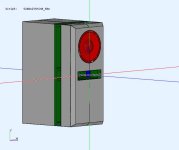
Here are the fields for the Radian 5208C
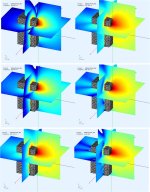
here are the fields for the PTT8 viewed from the top to show just the horizontal pattern. You can see its got good rear rejection as well as side nulls, probably due to the roll off of absorption with frequency. This isn't classic cardioid but I think its actually beneficial for reducing SBIR in the system simulation and the so-called real world.
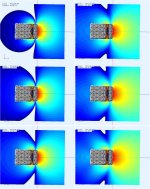
These are very encouraging results for me but its still early in the game. One of the things I want to do is implement acoustic low pass filter modules that I can slide into and out of the slots for trimming. These modules will be simple sandwiches of Basotect between plywood and designed so that the only way sound can exit the box is through a fixed thickness of absorber. If this works, then we may get to the point of having predictable results going from simulation to implementation.
Even so, I have gotten interesting results computing and plotting the fields in addition to the usual polar maps. I started with the ATH round top model but moved to my own nodes-based parameterized model of a rectangular box. This model includes the driver magnet and T/S parameters and allows damping to be applied selectively to surfaces within the model. I followed DonVK's advice as to the damping value and frequency dependency.
Here is a picture of my model. It will have a radian 5208C 8" coax in the top half, as shown, covering 400 to 1200Hz and a PTT8, not shown, in the bottom half covering 100 to 400 Hz. There will be a 10" subwoofer facing rear in back similar to the D8D 8C. There is a port hole in the baffle that keeps the vertical radiation pattern vertical. It is used by both drivers. The slots and HinB are 50 mm wide'

Here are the fields for the Radian 5208C

here are the fields for the PTT8 viewed from the top to show just the horizontal pattern. You can see its got good rear rejection as well as side nulls, probably due to the roll off of absorption with frequency. This isn't classic cardioid but I think its actually beneficial for reducing SBIR in the system simulation and the so-called real world.

These are very encouraging results for me but its still early in the game. One of the things I want to do is implement acoustic low pass filter modules that I can slide into and out of the slots for trimming. These modules will be simple sandwiches of Basotect between plywood and designed so that the only way sound can exit the box is through a fixed thickness of absorber. If this works, then we may get to the point of having predictable results going from simulation to implementation.
Could you upload its contour plot, please?Here is a picture of my model. It will have a radian 5208C 8" coax in the top half, as shown, covering 400 to 1200Hz and a PTT8, not shown, in the bottom half covering 100 to 400 Hz. There will be a 10" subwoofer facing rear in back similar to the D8D 8C. There is a port hole in the baffle that keeps the vertical radiation pattern vertical. It is used by both drivers. The slots and HinB are 50 mm wide'
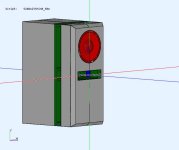
I'm sorry, but I still don't see how gating would affect the quality of a polar response measurement because the sound field created by a speaker around itself in a small room will be the same as the one in an anechoic environment, with the exception that after a few milliseconds reflections will start imposing themselves on the measurement. Therefore, gating out those reflections will get you the same result as an anechoic measurement, with the caveat that resolution in the frequency domain will be reduced (significantly) below about 1kHz, and I would say that that is the big limitation to accurately measure a cardioid speaker. But as mentioned above, simulations and ground plane are some of the options to get around that.For a cardioid speaker design, the SPL of the front speaker at 180 degrees must be equal to the SPL of the rear driver at 0° ( In active cardioid design). If their SPLs are not the same the attenuation at the back side will not be effective. So, the method must be accurate to measure the said SPLs. I've found so far that the "gated measurement" is totally a good method for angles less than 90 degrees. The reason why I said "I'm still not completely sure" is this. In addition, it will be difficult to do it in small rooms. (180 degrees was an example and it will be more complicated in practice at all angles after 90°)
Haven't kept up on this thread to see what other resistive materials you or others may have used since the above.Not sure why enlargening the apertures killed the smooth response. The damping material was now in the apertures = further away from the driver frame with more space for driver to breathe past the melamine first. Less attenuation perhaps, maybe too high acoustic low pass, maybe change in path difference or any combination of various reasons. Anyway, shows that it is not all in the damping material. Hopefully everyone gets their projects tuned in, eventually 🙂
David Gunness (Fulcrum Acoustic,LLC) has mentioned "Hydrophobic acoustically resistive cloth as used in cell phone mic protection helps make the calibrated resistive element process repeatable " (around 38:55) in this video:
Dave also wrote:
"The difference between an "aperiodic port" design and our passive cardioids is the acoustical mass of the ports and the amount of resistance. The acoustical mass in our passive cardioids puts a second-order low-pass filter a little below the frequency below which we want cardioid behavior. The resistance is just enough to damp the Helmholtz resonance to "slightly underdamped" (Q of about 1). An aperiodic port design has almost no acoustical mass and is dominated by resistance, so there is essentially no Helmholtz resonance and the resulting first-order low-pass corner is well above the passband; so it operates simply as a resistive leak that damps the sealed box resonance. If you look at the impedance of our passive cardioid subs, you'll see a trace of the double peaks of a ported box, but the dip between them doesn't go nearly as low. That's the effect of the port resistance.There is still significant reduction of excursion around the Helmholtz frequency, and the summation of the rear radiation and front radiation increases the output over about 1 1/2 octaves. If you try to stretch the cardioid behavior beyond 1 1/2 octave, there will be a penalty in low frequency extension and maximum output.
Adding "conventional" ports to the front of the cabinet would essentially short out the rear ports, which would destroy any cardioid behavior."
I don't know if the Fulcrum Acoustic passive subcardioid cabinets use the Saatifil "Acoustex" brand, but they list their list of main applications include mobile phones, microphones, headphones and loudspeakers.
The Acoustex materials specifications include the "Specific Airflow Resistance" in both MKS rayls [Pa s/m] (from 6 to 155) and[CGS Acoustic Ohms over 1 cm2] (microbar s/cm3) ranging from .06 to 15.5 ohms.
No idea how you might plug those numbers into simulation programs, but having heard how well the Fulcrum subcardioid subwoofers were able to control directivity at the 2017 Orlando InfoComm, thought it worth bringing up again.
Art
Last edited:
- Home
- Loudspeakers
- Multi-Way
- Resistive port cardioid active speaker insipired by D&D 8C
